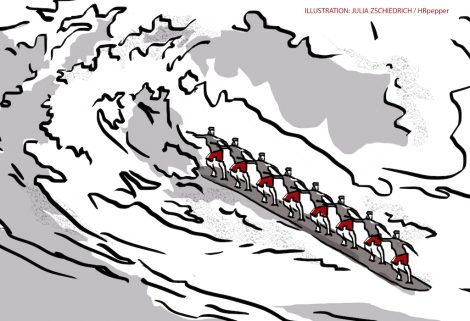Payment for more innovation is (un)effective

Whether incremental or radical, product- or process-related – organizations need innovations in order to remain competitive in the long run. Accordingly, most jobs nowadays comprise an innovation component. Against this background, Bruce Curran and Scott Walsworth pose a simple, yet exciting question: Is it possible to stimulate innovations by targeted compensation? From a theoretical viewpoint, for any compensation practice there are arguments for both a positive and a negative influence on innovation.
Curran and Walsworth address their research question based on the “Canadian Workplace and Employee Surveys” (1999-2006). They tested the influence of diverse compensation practices on the frequency and significance of innovations at the establishment level. Besides, they collected information on organizational characteristics (e.g., sales per employee, industry) as well as other characteristics related to innovation (e.g., expenditures on training, formalized innovation strategy).
Curran and Walsworth show in their study that the level of salary is neither related to the frequency nor the significance of product or process innovations. This finding supports the view that employees with a strong preference for creative, intrinsically rewarding work readily accept lower salaries in order to work for an innovative company (Gupta & Singhal, 1993; Long, 2010). It is also consistent with the hypothesis that relatively high salaries crowd out the entrepreneurial mindset necessary for innovations (Schuler & Jackson, 1987).
Similarly, individual performance-related pay is also not significantly related to the frequency and significance of innovations. Scientific explanations on the one hand suggest that extrinsic incentives crowd out intrinsic motivation. On the other hand, past research points out that individual performance-related pay is regarded as controlling rather than incentivizing innovation-related activities (“exploration”).
In contrast, establishments with team/group variable pay or organizational variable pay (i.e., profit sharing) are characterized by a higher likelihood to frequently generate (significant) innovations. Risk sharing is discussed as a possible explanation for this finding, since individual failure has a less direct impact on these compensation components. In addition, establishments with above-average benefits are characterized by a higher likelihood to frequently generate (significant) innovations. Curran and Walsworth suggest that above-average benefits constitute both stimulus and reward for affective commitment, which is considered essential for innovation-related employee behavior.
Surprisingly, an association between human capital-related pay (i.e., for possessing/acquiring human capital) and innovation output could not be detected – further research is needed to clarify the causes. What is certain, however, is that expenditures on training and the training-coverage of the workforce are positively associated with innovation output (see, e.g., Johnson et al., 1996; Walsworth & Verma, 2007; Tan & Nasurdin, 2011).
Although the study by Curran and Walsworth does not reveal all causal mechanisms, the results suggest that their research question can, at least tentatively, be answered in the affirmative: It is possible to stimulate innovations by targeted compensation. In this context, benefits, team/group variable pay, and profit sharing constitute promising parameters. An according compensation system should probably not be regarded as a substitute for (additional) investments in training as a means to increase innovation output, but may provide supplemental momentum.
Sources

